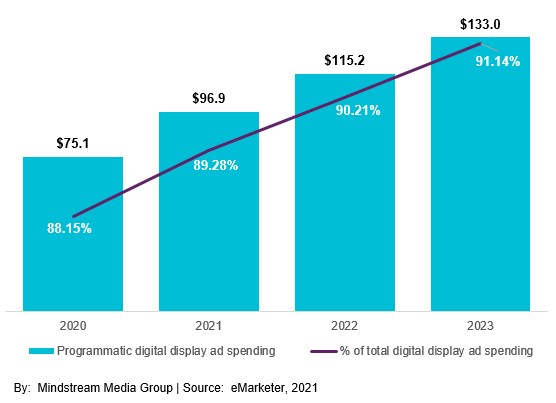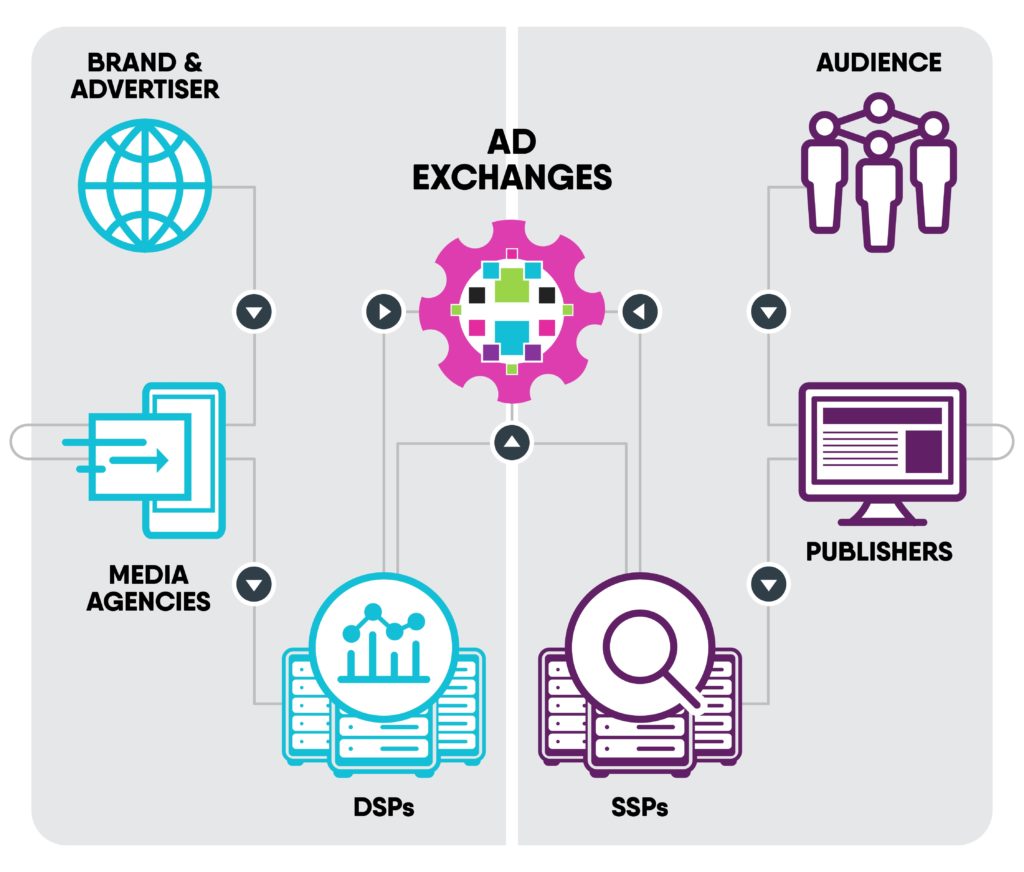What You Need to Know About Programmatic Advertising
In the past, real-life human beings were solely responsible for buying and placing ads on media platforms. If that sounds incredibly inefficient to you, it’s because it was. Humans are prone to mistakes, forget things, call in sick, show up hungover, etc. Compared to machines, humans are slow and a lot less capable of handling ad buys at scale.
To make up for our shortcomings, advertisers have increasingly turned to programmatic advertising technologies to facilitate the process of buying and placing ads. By 2023, U.S. advertisers will dedicate more than 91 percent of their total digital display spending to programmatic ad buys, according to eMarketer.
U.S. programmatic digital display advertising spending
(in billions and % of total digital display ad spending)

With the ability to scale and automate complex tasks, programmatic technologies are already a dominant force in digital marketing. And, programmatic will only become more valuable as agencies and tech companies introduce ways to make the process even more efficient. To make sure your brand can take full advantage of the opportunity, here’s an introduction to programmatic advertising and what it can do for you.
What exactly does programmatic advertising mean?
Programmatic advertising is the practice of using technology to automate the buying and selling of ad impressions on media platforms. These impressions could be for digital display banners, native advertising, online video ads and a myriad of other ad types.
What is the primary function of programmatic technology?
In terms of the ad buying process, the main function of programmatic technology is to automate the bidding process of auctions that occur in real time when users visit webpages and websites serve ads. These real-time auctions allow advertisers to buy ad impressions and publishers to sell advertising space at scale.
How does programmatic technology automate bidding?
In a programmatic setting, publishers serve ads dynamically based on the individual user visiting a webpage or app, thereby limiting impression waste by focusing on the right users in the right place at the right time. To do this, publishers use real-time auctions to determine which ad shows each time a user visits one of their webpages or app screens.
For example, let’s say you visit a webpage. When you click on the URL, the browser sends information about you (e.g., demographic information and online behaviors) and the webpage (e.g., main page topics) to a series of platforms that handle the buying and selling of ad impressions.
Upon receiving the information, these platforms initiate an auction to determine what ads you’ll see on the page. The auction’s buyers are brand advertisers and their media/tech partners who set targeting criteria to determine how much they’re willing to pay to get their ad in front of specific audiences.
Using a process called “real-time bidding,” these platforms can handle this auction – along with billions of others each day – in the milliseconds between the time you land on the page and when all the content loads.
Why is programmatic ad buying a good thing for advertisers?
The biggest reason is what we just alluded to – programmatic ad buying allows advertisers to target ads based on specific consumers rather than having to buy set inventory directly from publishers. This type of ad buying allows your brand to focus more on who you’re serving the ad to, than where the ad displays.
Programmatic ad buying allows brands to focus on who they’re servings ads to, rather than where they’re serving the ad. Share on XAnother benefit to advertisers who partner with a programmatic agency like Mindstream Media Group? We have certified programmatic traders working in tandem with platform AI to monitor and optimize campaigns, combining human strategy and ad technology to achieve the most efficient results.
Who are the major players in programmatic advertising?
Remember how we mentioned there are a series of platforms that handle the buying and selling of ad impressions? Well, that series includes a fairly intricate roster of platforms and vendors to make sure the right ads from the right brands get in front of the most relevant consumers. To give you a closer look at the logistics of programmatic advertising, here’s a brief overview of the major players:
Brands
The companies that are looking to reach target audiences with their advertising messages.
Media agencies
The vendor partners that connect brands with programmatic platforms and develop campaign strategies.
Demand-side platforms (DSPs)
The platforms that help advertisers and agencies analyze available inventory and adjust bidding strategies in real-time.
Ad exchanges
The platforms that handle the buying and selling of programmatic ads (i.e., where the real-time auctions take place).
Supply-side platforms (SSPs)
These platforms help publishers identify audience segments, manage price points and facilitate sales across ad exchanges.
Publishers
The companies that sell ad impressions on the websites, platforms and apps they own.
Audiences
The people who view the ads on publishers’ websites and apps.

If your brand is already leveraging programmatic advertising, check out this blog on how to make sure you’re getting the most out of your campaigns. If you haven’t started running programmatic campaigns yet, contact Mindstream Media Group to learn how our innovative display solution can help fast-forward your business.
Editor’s note: This post was originally published in April 2019 and has been updated for freshness and accuracy.
More from Mindstream Media Group

Meet the Mindstreamer – Chandler Swanner
Chandler Swanner’s interest in advertising dates back to her childhood. Her mother (and role model in life) was a Media […]

Third-Party Cookie Phase-Out: What Marketers Need to Know
Cookies are an essential part of internet usage, allowing websites to remember you and provide a more personalized experience. This […]

Meet the Mindstreamer – Kaya Bucarile
She plans and oversees media strategy for agency clients, working closely with project and platform managers to ensure that we […]
